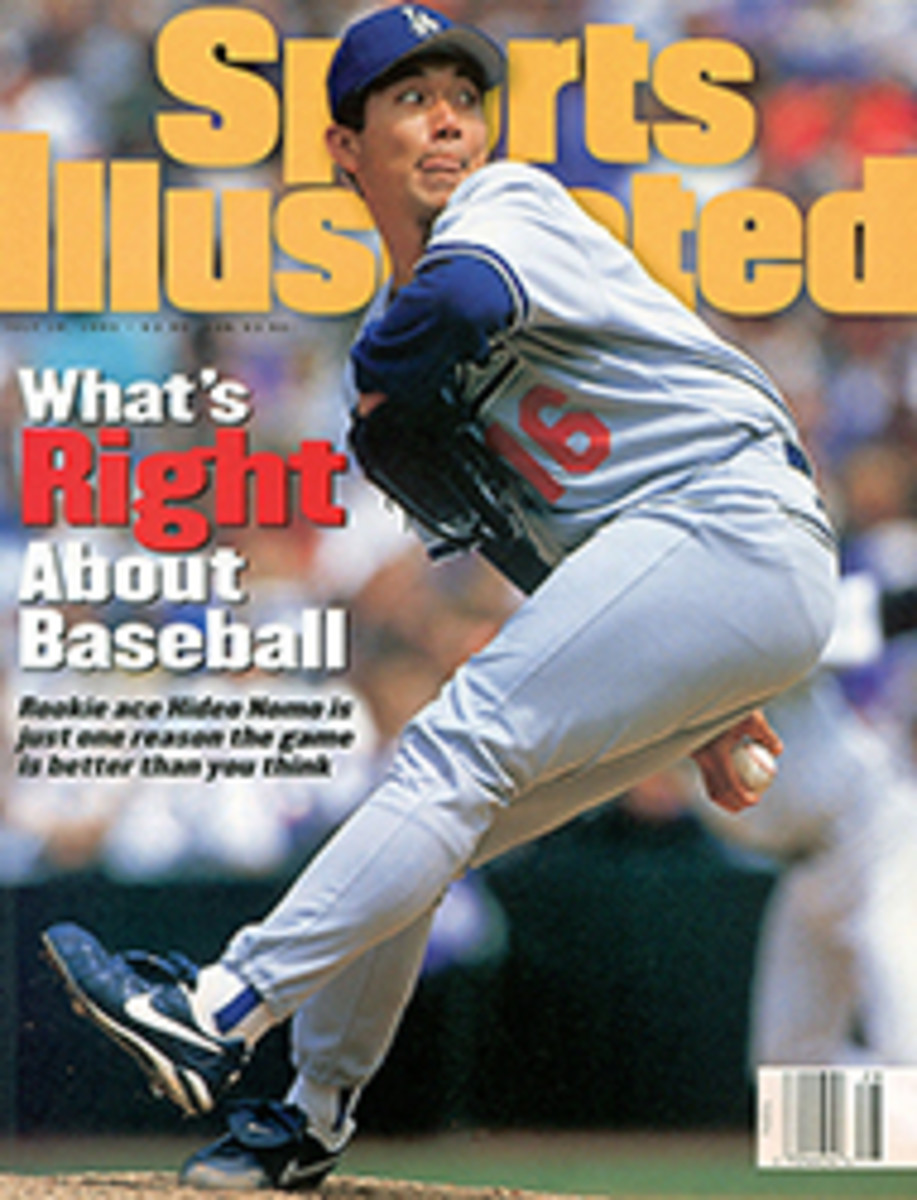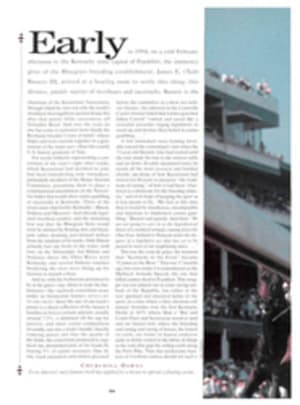
A CARD-CARRYING KOOSMANIAC THE AUTHOR HAS A HOLD ON THE MOST VALUABLE STANDARD-ISSUE CARD SINCE 1955
When men look back at their boyhood, what do they miss? A full
head of hair? A pair of jeans with more inches in the inseam
than in the waist? For a few of us, it's our stashes of baseball
cards. Granted, we're not talking Rosebud here, but we may be
talking Rose (the Cincinnati Reds' Pete, whose 1963 rookie card
fetches up to $650) and Bud (the New York Mets' Harrelson, whose
'67 card might bring a buck and a half). In my case we're
talking about a '68 Jerry Koosman, which in near-mint condition
lists at $1,600.
The mother who unwittingly throws out her son's collection--and
thus his college tuition money--is a cliche by now. The marvelous
paradox, of course, is that if countless mothers hadn't flushed
away their sons' childhoods, the remaining cards wouldn't be
worth so much. My mom committed no such betrayal.
While still a boy in Hollister, Calif., I recognized the
financial promise of my collection, and I peddled thousands of
cards to the neighborhood card shark. I sold him just about
everything--the Joe Morgan rookie cards along with the doubles of
Felix Mantilla--all for $6.50. I kept a few cards for sentimental
reasons, threw them into a plastic bag and forgot about them,
perhaps consigning them to some future oblivion when Mom did her
spring cleaning.
But I didn't raise my mother to be anybody's fool. A couple of
years ago, after one of her cleaning binges, she gave me the bag
of cards. I promptly tossed them in a closet and left them there
until I could examine them at my leisure. When that time finally
came, I discovered, in the remnants of a once mighty collection,
a few small gems: a '55 (Bowman) Hoyt Wilhelm, a '59 Robin
Roberts, a '61 Mickey Mantle, a '65 Dennis McLain and a '68 Bob
Clemente. And there, to my delight and good fortune, I found my
Koosman rookie card, the most valuable regular-issue card of the
past 40 years.
If you can't quite picture Koosman, don't feel bad. He spent
much of his career in the oversized shadow of teammate Tom
Seaver and all of it just a step away from full-blown fame.
But in 1968, when he was a high-kicking 24-year-old farm boy
from Minnesota, Jerry Koosman hit the National League like a
line drive off Willie McCovey's bat. In the last 30 years no
rookie pitcher other than Mark Fidrych (in 1976), Fernando
Valenzuela (1981) or Dwight Gooden (1984) has had the kind of
debut that Koosman had. Pitching for the woeful Mets, Koosman
started the season 4-0. In July he struck out Carl Yastrzemski
to end the All-Star Game and earn the save in the National
League's 1-0 victory. He finished the season 19-12 with a 2.08
ERA--marks that are particularly impressive given that the Mets
finished in ninth place, 16 games under .500. Koosman's wins and
ERA were club records.
Koosman had not played high school or college ball. He came to
the attention of the Mets by way of a glowing scouting report by
John Lucchese, whose official capacity with the Amazin's was
that of Shea Stadium usher. In the Army, Lucchese's son had
caught Koosman for the base team at Fort Bliss, Texas, and he
told his father the big southpaw was a prospect.
The Mets sent Red Murff to scout Koosman. "He offered me $1,600
to sign," Koosman told reporters his rookie year. "I turned him
down, so the next time he offered me $1,500. Every time he
talked to me he offered me $100 less, and I finally signed for
$1,200. I figured that if I didn't sign pretty soon, I'd end up
owing them money."
I discovered Koosman four years after the Mets did. He began his
rookie season in the major leagues by shutting out the Los
Angeles Dodgers 4-0. In his second start, the season opener at
Shea Stadium, Koosman faced my team, the San Francisco Giants.
Koosman immediately got into trouble, letting the first three
Giants reach base in the top of the first. That brought to the
plate Willie Mays, a veteran of 16 major league seasons and
arguably the greatest centerfielder of all time.
Mixing his pitches, Koosman worked the count to 1 and 2, then
blew a third strike by Mays. Next Jim Ray Hart popped up to the
catcher, and Jack Hiatt struck out. With the bases loaded and no
outs, Koosman had plowed through three right-handed batters
without allowing a ball into fair territory. He settled down and
won the game 3-0. He surrendered just seven hits, struck out 10
batters and became the first pitcher in Met history to throw
back-to-back shutouts. By the next morning this Giant fan was
rooting for the new Gotham ace. I had Koosmania. I cut out every
newspaper story I could find on the Met-Giant game and began a
scrapbook on the rookie southpaw.
Through April, May and June and into July, I followed Koosman's
every start with the all-consuming interest only an 11-year-old
can bring to baseball. Somewhere along the line I added a Topps
baseball card to my growing Koosman collection.
After the excitement of seeing Kooz end the All-Star Game by
fanning Yaz, however, my attention began to drift away from New
York and back to the Bay Area, where the Giants were enjoying
their own phenomenal pitching success story in Juan Marichal,
who shut out the Dodgers on Aug. 1 to run his record to 20-4.
But even after Koosman's grip on me relaxed (the scrapbook
disappeared), I kept a grip on his first baseball card.
Koosman was paid $15,000 for his first year in the big leagues, a
bargain in anybody's book. So how is it that a player who didn't
command much money as a big leaguer--Koosman made $600,000 in
1985--should now be so valuable on a baseball card? The answer to
that question reveals the dominant characteristic of Koosman's
major league career: As other players seized the limelight, the
talented lefthander stood in their shadows. On his first
baseball card, Koosman was paired with future strikeout king
Nolan Ryan.
Koosman's career is dappled with near misses. Whenever he was a
step away from stardom, someone bumped him into the wings. At
the end of his first year in the majors, after tying a National
League rookie record with seven shutouts, Koosman missed winning
the Rookie of the Year Award by one vote. He lost that honor to
Cincinnati catcher and future Hall of Famer Johnny Bench.
Koosman's teammate Seaver had won the rookie award the year
before, and that may have deflected some votes toward Bench.
The following year Koosman was 17-9, with a 2.28 ERA, but all
the clamor was for Seaver, who was 25-7 and won the Cy Young
Award. Even in the '69 World Series, when Koosman pitched
superbly, surrendering just seven hits in 17-2/3 innings and
beating the Baltimore Orioles twice, someone else took the bows:
Met first baseman Donn Clendenon hit three home runs, batted
.357, was named Series MVP and drove home a new Dodge Charger.
In 1976, Koosman was 21-10 with a 2.70 ERA and 17 complete
games, and he thought he had a chance of winning the Cy Young
Award. He finished second to Randy Jones of the San Diego Padres
in what some saw as a makeup vote for Jones, who had finished
second to Seaver the previous year. "Go back over the years, and
you'll see it happening pretty much the same way," Koosman once
said. "What's happened with Tom and me is kind of history."
If Koosman will be forever linked with Seaver in Met history, he
will be paired for eternity with Ryan in card history. As
recently as 1989 their card could be had for $175, but as Ryan
continued to mow down batters, win games and pitch no-hitters
well into his forties, the price spiraled upward.
The card also developed a certain notoriety. Four years ago
13-year-old Bryan Wrzesinski of Addison, Ill., bought the card
for $12 from a harried card-shop clerk who had misread the final
two zeroes on the price tag. The shop's owner took Bryan to
court, demanding the card back or damages. (Ultimately the two
parties agreed to auction the card, with the proceeds going to
charity. The card, which had an evidence sticker pasted over
Koosman's face, brought $5,000.)
Several years ago a card dealer in Texas offered $100 for any
"Jerry Koosman" rookie cards. It was an attempt to rid unsavvy
owners of the card, which is and always will be remembered as
the "Nolan Ryan" rookie card. Even in retirement, Koosman is
destined for the shadows. But he shouldn't be remembered simply
as Topps trivia. Consider his numbers--222 victories, 33
shutouts, 2,556 strikeouts (17th on the alltime list), three
World Series wins, two All-Star appearances--and you too may
decide that Koosman was much more than Seaver's caddie or Ryan's
rookie cardmate.
I picture Koosman as the superlative rookie of my long-lost
scrapbook, the young southpaw with 19 wins and seven shutouts.
Ryan, his rookie cardmate, was 6-9 in 1968. So I will keep
thinking of my treasured Topps as the "Jerry Koosman" rookie
card. And it can't be had for $100.
Bruce Anderson, editor of "Stanford Magazine," says baseball
cards were his best investment ever.
COLOR PHOTO: JOHN BURGESS Anderson is unambivalent about who was the top National League rookie in 1968. [Bruce Anderson covering Nolan Ryan's face on the 1968 rookie stars baseball card shared with Jerry Koosman.]
COLOR PHOTO [See caption above] [Pitching statistics on reverse side of Jerry Koosman andNolan Ryan's rookie baseball card]
B/W PHOTO: HERB SCHARFMAN Koosman (36) spent many years in the long shadow of Seaver (top). [Jerry Koosman pitching.]
B/W PHOTO: TONY TRIOLO [See caption above--Tom Seaver pitching.]

